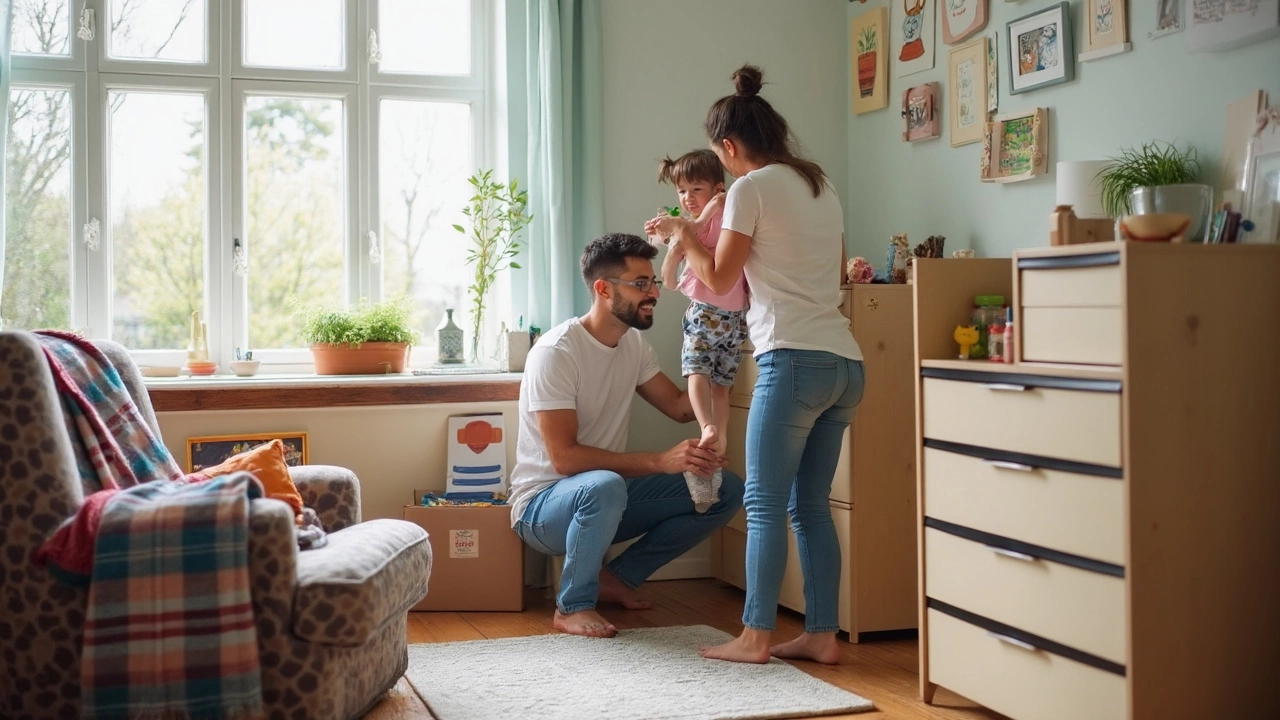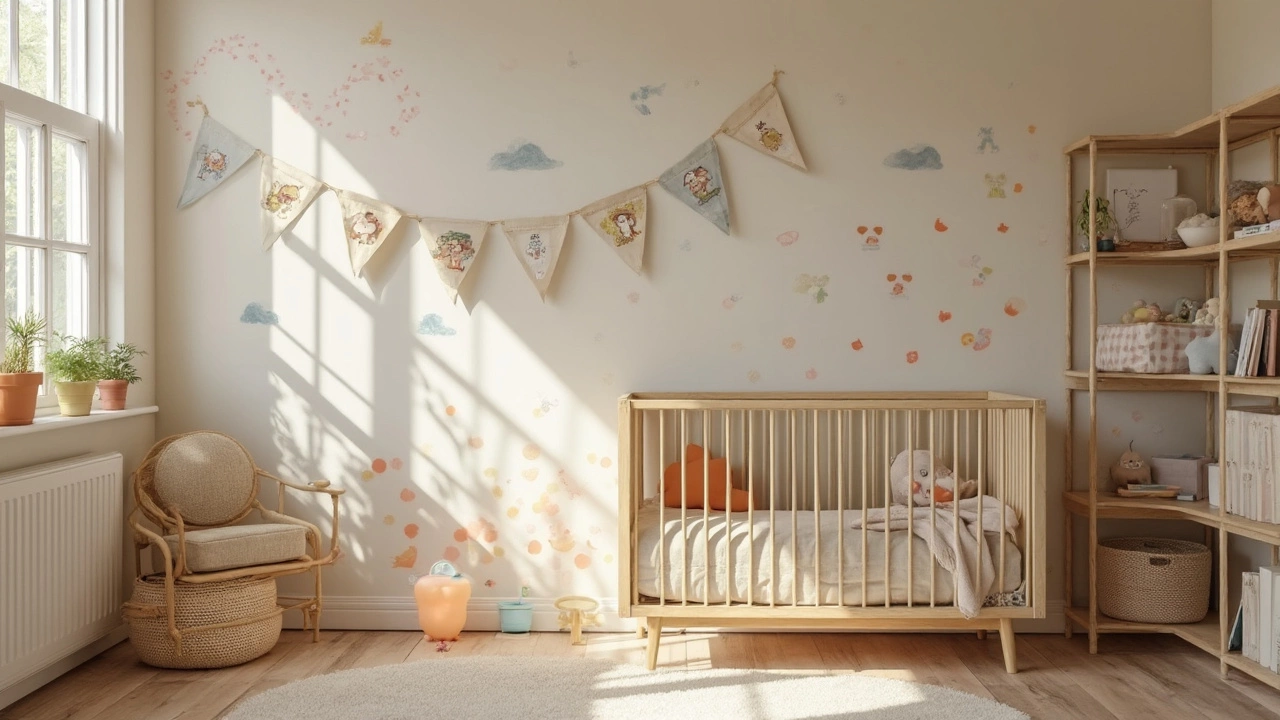You don’t need fancy furniture or a designer to give your baby a great nursery. Those Instagram-perfect rooms often cost a small fortune, but you can pull off a sweet, safe, and stylish space for half, or even a quarter, of most people’s budgets.
Start by skipping the matching nursery sets that stores try to sell you. They’re super pricey and, honestly, babies won’t care what brand name is on the crib. Focus on basics: a safe crib, a changing spot, and a place for clothes or essentials. Shop at regular furniture stores, not just baby boutiques. Sometimes a simple three-drawer dresser, like the one my friend scored at IKEA, can double up as a changing station—just add a pad on top. This one trick alone saves you the cost and space of buying a separate changing table.
Want another way to stretch your dollars? Think about what you already have. A comfy old chair can turn into a rocking or feeding spot, and regular bookshelves work just as well for baby books and baskets as the ‘nursery’ ones do. Most babies outgrow tiny bassinets and changing units lightning fast, so it’s smart to pick stuff that can stick around a few years, not just a few months.
- Smart Furniture Shopping
- Secondhand Finds and Swaps
- DIY Decor for Pennies
- Saving with Multi-Use Pieces
Smart Furniture Shopping
The nursery is all about function, not perfection. You don't need a mile-long checklist—just smart moves. The biggest budget win is being picky about what you really need. Skip the full matching set. Instead, get a safe, reliable crib (they’re federally regulated now in the US, so every new crib meets safety standards—no need to splurge on the top shelf). Walmart and IKEA both sell sturdy cribs under $150. If you want one that grows with your kid, look for a convertible crib—it turns into a toddler bed later, saving money down the road.
Dressers double as changing tables with just a pad on top. That’s way cheaper than getting a table that works only a year. I know parents who found deals on solid wood dressers at thrift shops, then painted them with low-VOC paints. They last forever and match any color scheme you want later.
Here’s a helpful look at what nursery furniture really costs in 2025:
| Item | Average Price New | Cheapest Store |
|---|---|---|
| Crib | $120 - $300 | Walmart, IKEA |
| Changing Table | $70 - $200 | Target, Amazon |
| Dresser | $90 - $250 | IKEA, Secondhand |
| Rocking/Glider Chair | $100 - $350 | Amazon, Facebook Marketplace |
If you’re okay with simple, you can furnish the room for under $400 if you stick to the best basics and don’t get roped in by “nursery” labels. Buy direct from manufacturer sites when possible—they often have better deals than big box stores. Consider furniture that grows with your baby or easily moves to other rooms. That way, you're not spending money just for a few months.
When shopping for cheap nursery furniture, check for certifications like JPMA or Greenguard GOLD if you’re concerned about chemical safety. No need to break the bank to get safe, quality gear. And if you’ve got time, watch for store coupon days or end-of-season sales. It’s one of the easiest ways to save $50 or more on bigger ticket items.
- Focus on cribs and dressers that serve double-duty.
- Avoid buying a furniture set—mix and match instead.
- Check store clearance sections in person; online deals aren’t always the lowest.
- If assembly isn’t your thing, look for floor models or open-box returns—they’re cheaper and usually ready to go.
Secondhand Finds and Swaps
Getting a cheap nursery doesn’t mean you have to settle for worn-out or dodgy stuff. The amount of gently used baby furniture out there is mind blowing—babies outgrow cribs and gear so fast, there’s always something close to new. I once found a barely-used crib on Facebook Marketplace for under $60, and it met all the latest safety standards. Check for the JPMA (Juvenile Products Manufacturers Association) sticker if you’re questioning quality. If you want to double-check recalls, the Consumer Product Safety Commission (CPSC) has an easy search tool that’s free to use.
Besides the usual suspects like Facebook Marketplace, Craigslist, and OfferUp, try local parent groups on social media. I’ve swapped baby gear with neighbors I met through these apps, sometimes totally for free. There are even organized swap events in many cities—ask at your library, church, or through apps like Nextdoor.
Here are a few things to look out for when getting secondhand nursery furniture:
- Cribs: Make sure the slats are no more than 2 3/8 inches apart, and that there’s no drop-side (they’re banned since 2011).
- Mattresses: Always buy new for hygiene, but secondhand waterproof covers can save money.
- Dressers/Storage: Check for loose screws or wobbly drawers and, for safety, anchor heavy stuff to the wall.
- Rockers/Gliders: Test them for squeaks or broken parts—sometimes all they need is a little DIY.
Wondering what people are paying for good-condition secondhand pieces? Here’s a quick look at average prices I’ve found for common nursery items locally:
| Item | Secondhand Price ($) | Retail Price ($) |
|---|---|---|
| Crib | 50 - 150 | 200 - 400 |
| Changing Table | 30 - 70 | 100 - 250 |
| Rocking Chair/Glider | 40 - 120 | 150 - 400 |
| Dresser | 35 - 100 | 120 - 300 |
One last tip: Baby swaps don’t just save money—they keep big stuff out of landfills, too. If you end up with extras, pay it forward by donating or swapping back when your baby outgrows things. Everybody wins, and your wallet will thank you.

DIY Decor for Pennies
Decorating a nursery doesn’t have to eat up your budget. In fact, some of the cutest rooms online are packed with DIY touches that barely cost anything but still have that personal vibe.
Wall art is one of the simplest places to start. Instead of splurging on framed prints or decals, make your own. Print out free nursery printables you can find on Pinterest—just Google “free nursery art printables”—and stick them in cheap frames or even on clipboards for a laid-back look. If you have a steady hand, try painting simple shapes or fun quotes directly on the wall. Washi tape can also make easy, removable wall designs—stripes, triangles, or a custom pattern—and a whole roll rarely costs more than a couple of bucks.
Bunting and garlands are classic. Grab some string and scrap fabric, felt, or even old baby clothes and cut them into triangles, circles, or little animals. Stitch or glue these onto the string, then hang them over the crib or across the window. It’s fast, looks great, and you can brag that you made it yourself.
For storage, think baskets with personality. You can transform plain dollar store baskets with a little bit of paint, yarn tassels, or stick-on letters. This trick not only organizes diapers and toys but also adds color or texture to the space.
- Reuse glass jars for cotton pads, baby q-tips, or pacifiers. Paint the lids for a cute finishing touch.
- DIY mobiles are easier than you think. All you need is an embroidery hoop, fishing line, and lightweight objects like paper stars or felt clouds. Hang the whole thing from a ceiling hook (just keep it out of baby’s reach).
- Turn old picture books into a wall collage. Tear out your favorite illustrations and tape them directly to the wall in a grid pattern. Easy and replaceable if you want a new look later.
So if you’re looking for cheap nursery decoration ideas, roll up your sleeves and get creative. Not only will you save big, but you’ll end up with a nursery that really feels like yours.
Saving with Multi-Use Pieces
If you want a cheap nursery that’s actually functional, multi-use furniture is your new best friend. Think about it: the less stuff you have to buy, the more cash stays in your pocket (and the more space you keep free for diaper runs and tummy time).
Look for a crib that converts into a toddler bed or even a daybed as your child grows. Those cribs might cost a little more at first, but you won’t have to buy a new bed every couple of years. Some models even switch all the way to a twin bed with a few extra slats. Classic brands like Graco and Babyletto have been putting out these convertible cribs for years, so it’s not hard to find them either new or gently used.
A standard dresser can do double duty as a changing table if you just pop a non-slip changing pad on top (and maybe secure it with Velcro strips — safety first). This saves the cost and floor space of a separate changing unit. Plus, dressers usually last way beyond the baby stage, unlike those little changing units that get tossed or donated within a year.
Rocking chairs and gliders? Pricey. Try using a soft armchair you already have, or look for a hand-me-down. Add a throw pillow for extra back support and you have a cozy spot for feedings, storytime, or even just scrolling on your phone while baby naps.
If you’re tight on closet space, stack cube storage or simple bookshelves with bins. They stash everything from onesies to toys and make it easy to spot what you need. When your baby grows, those shelves can move on to books, art supplies, or school gear—no waste, no extra spending.
The trick is not to get pulled in by targeted ‘nursery’ marketing. Multi-use pieces that work past the baby months stretch your dollars way farther. Plus, they help keep things uncluttered—no one wants to trip over gear they only used for six months.
